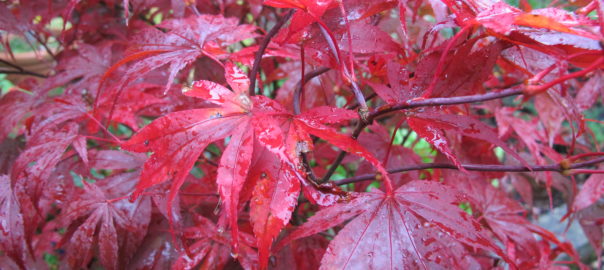Autumn is now well advanced, but hopefully our careful dead-heading of bedding plants and herbaceous perennials, extended the flowering season well into October. Now summer bedding is spent and the asters are the stars of the season along with the remaining dahlias hanging on until the first hard frosts.
Colour at this time is mainly provided by the leaves of trees and bushes as they take on their autumn hues before they drop.
We all have our favourite trees for autumn colour and the list to choose from is enormous. Certainly Japanese Acers will feature along with many Hazels and Amelanchiers. For those whose gardens have missed out this year, these trees can still be planted to be ready for next year. Planted in a good sized hole and filled to the level of the compost in the pot, they will get established before the very cold weather. If some mycorrhizal fungi are added to the hole before planting it will encourage a healthy root growth to give the plant a good start.
What to do now?
Recently in my experience the autumns have been getting longer and plants have continued to put on a good show through October and into November. However, this can all come to a sudden halt with bad weather making settling the garden for winter a cold and wet experience. So there is no time to delay, if you have not already done so collect seed off the hardy perennials ready for sowing to provide more stock for next year. Some seed heads can be left for the winter for food for the birds. Echinacea, Echinops, Fennel and other plants with large seed heads can also look very beautiful when clothed in frost, and so can be left. Otherwise the perennials should be cut back, put mulch over the more tender varieties such as agapanthus or some fuchsia and cover with a bell cloche.
Perennials that have become too big for the space they are in can also be divided at this time. Dig up, divide with a sharp spade, and then replant the best bits into separate places along with some new compost. As the soil is still warm at this time they will be able to develop their roots before the real cold of the winter sets in.
The lawn should have had its last mow of the season. However make sure it is well aerated by digging a garden fork in at intervals. It can also take an autumn feed to encourage root growth for the next season. Otherwise, all you need to do is just make sure that you collect any tree leaves so that they do not destroy the grass. These may be stored for leaf mould in either a wire enclosure or a plastic bag with holes pierced in it for ventilation. They take a long time to rot down, so will not make compost for twelve months, but could be used for a mulch after six.
Some pruning can also be done in these cold months. Cut roses down so that they are not too tall and catch the strong winds. This prevents them swaying in the wind and loosening the roots. Acers, Birches and vines should also be pruned when dormant to stop bleeding. Apples and pears grown in the open can be pruned at this time, but leave those grown against a wall until February.
Also make sure you have grease bands around the trunks of the fruit trees to stop winter moth damage. If you have stakes or supports on the tree, put bands round these as well.
What is still pretty?
When your summer bedding plants have been taken out of the pots, freshen the compost and put in some winter bedding as we can still have a lovely display of planting in our pots throughout the winter. Garden centres will sell you a pot already planted with a tasteful collection of plants, but a more personal note is sounded by putting your own ideas together. Winter pansies and violas are popular and available in a wide range of colours, as are primulas.
The primulas, primroses and polyanthus are spring flowering plants but will still flower during mild spells in winter. There are some that will have already started and will continue to send out splashes of colour from now until it is time for the summer bedding. The pots can be bulked out with interesting greenery such as small box or yew bushes.
Ajuga reptans, dead nettles (lamium) or small heuchera can all add colour and texture to your arrangements. Other favourites include Skimmia, Gaultheria procumbens with its red berries and any number of winter flowering Heathers. Some Heathers are sold sprayed a bright colour, but this fashion is perhaps an acquired taste, and you need to be aware that the colour you see is not from nature.
As winter progresses remember to keep an eye on your stored dahlia tubers. Throw out any that have gone soft or have mould.
What to look forward to?
Looking forward to next spring, one of the most magnificent sights is a magnolia in full flower. Large trees such as the Magnolia soulangeana put on a wonderful show, but can be too large for many gardens. However all is not lost as there are some varieties that are not so large and can also be pruned to keep them in check. Two varieties that fit the bill are magnolia stellata and the magnolia liliiflora nigra. They can both be kept to a reasonable size, with M. stellata flowering from the middle of March, and M. liliiflora later in April. M. liliiflora can also continue to produce a smaller number of flowers, after its first flush, well into August.
So there we are, there is much to look forward to, but in the meantime have a colourful Winter.
(By Berkshire Woman Gardeners)


